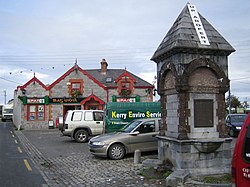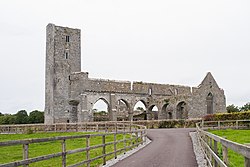Ardfert
| Ardfert Irish: Ard Fhearta | |
| County Kerry | |
|---|---|
 Fountain at The Square in Ardfert | |
| Location | |
| Grid reference: | Q782211 |
| Location: | 52°21’0"N, 9°40’60"W |
| Data | |
| Population: | 771 (2022) |
| Local Government | |
Ardfert is a village in County Kerry. Historically a religious centre, the economy of the locality is driven by agriculture and its position as a dormitory town, being only five miles from Tralee. The population of the village was 749 at the 2016 census.
Name
The village's name signifies, according to Sir James Ware, "a wonderful place on an eminence", or as some interpret it, "the hill of miracles." Ardfert has also been considered a corruption of Ard Ert, "the high place of Ert or Erc", so called after the fifth century Irish Bishop Saint Erc, who made the place a bishop's seat. Ardfert was written by the Four Masters as Ard-ferta, the height of the grave.[1]
History
Ardfert is a parish in the Barony of Clanmaurice, County Kerry, anciently in the territory of Ui Fearba/Hy Ferba, of which the O'Laeghain (O'Leyne, Leen or Lane) were once the Gaelic Lords, until Norman invasion of Ireland.

Ardfert is the home of St. Brendan's Ardfert Cathedral, which was destroyed in the Irish Rebellion of 1641, and the birthplace of St. Brendan the Navigator, who was educated about the year 500 AD. He founded a monastery there in the sixth century, but both town and monastery were destroyed by fire in 1089, and again in 1151.
The Norman influence can still be seen not only in the architecture, but also in local family surnames such as the Cantillons (Barons de Ballyheigue), and Fitzmaurices, and in place names, such as Ballintobeenig, a nearby townland below Mount Crusline named after St Aubin.[2]
Thomas FitzMaurice, 1st Baron Kerry founded a Franciscan friary there in 1253, and Nicholas, the 2nd Lord Kerry, built a leper house there in 1312. It was the seat of a bishopric until 1660.
The Crusader Knights Hospitaller of the Order of Saint John of Jerusalem (later known as Knights of Malta), also had some rights in Ardfert, although there is a record of a dispute between them and the Franciscans in 1325 about the market cross and pillory. They had already been established in the area in c. 1200 when Meiler FitzHenry, grandson of King Henry I of England, and Justiciar of Ireland under King John, established a preceptory at Rattoo under a Fra' William from Dublin.[3] Under the terms of a royal grant in letters patent of James I of England on 6 July 1612, the Lord of Kerry (FitzMaurice) could hold courts baron and leet.
The Annals of the Kingdom of Ireland, recount how in 1601, Prince Hugh Roe O'Donnell, on his way to the Battle of Kinsale, sent some of his kinsmen troops there to reconquer Ardfert, Lixnaw, and Ballykeally for his ally FitzMaurice. On the way, he visited and venerated a relic of the True Cross on the Feast of St. Andrew, on 30 November 1601, at Holy Cross Abbey, near Thurles, County Tipperary, which was a rallying point for the defence of the Roman religion in Ireland. From there he sent an expedition to Ardfert, to win a quick victory and recover the territory of his ally, Fitzmaurice, Lord of Kerry, who had lost it and his 9-year-old son, to Sir Charles Wilmot. The expedition captured Caislean Gearr (Short Castle, of which no trace remains), adjacent to the Cathedral in Ardfert. An O'Donnell from Tyrconnell remained behind in stewardship to hold it, according to "The Life of Hugh Roe O'Donnell, Prince of Tyrconnell"written by Lughaidh O'Cléirigh, circa 1603 in Gaelic.[4]
A large tomb in the grounds of the cathedral was built much later by John O'Donnell (1803–1879), the most prominent descendant two centuries later, and whose own direct male descendant was the late Patrick Denis O'Donnell (1922–2005), the Irish military historian. He owned the summit overlooking Ardfert (Mt. Crusline, Ballintobeenig, from where his ancestral O'Donnell of Tyrconnell, under authority of Prince Hugh Roe O'Donnell would have launched the battle to regain Ardfert for Lord Kerry in 1601). The family seat of John O'Donnell, at Tubrid mentioned by Samuel Lewis in his 1837 Topographical Dictionary of Ireland, passed through a female line to the O'Carrolls. The house expanded by John O'Donnell in Tubridmore was listed as an intended "protected structure" in the archaeological monuments section of the draft Kerry County Development Plan 2015–2021.[5]
In the early 19th century, the Earl of Listowel (Hare) was Lord of the Manor and held court every three weeks in Ardfert, through an appointed Seneschal, having bought those rights from the Earl of Kerry, Fitzmaurice.

The area's archaeological heritage includes the mediæval cathedral, St Brendan's, and associated churches, Temple na Hoe (Church of the young Virgin) and Temple na Griffin. Several have these have become heritage tourism attractions in the Kerry area due to their central location.[citation needed] The 13th century Franciscan Friary, to the north east of the village, was once an integral part of Ardfert Abbey - not an abbey at all but the name of the Talbot-Crosbie mansion destroyed by fire in 1922 by the IRA.
Five other structures included on the Record of Protected Structures (RPS) are located in Ardfert; St Brendan's Catholic Church (consecrated in 1855), the Old Gates of the Earl of Glandore's Demesne, the Talbot-Crosbie Memorial, the Ardfert Parish Room (now a site registered as derelict by Kerry County Council) and Brandon House. There are also many other structures within the village which are not included in the RPS, but are considered to be of considerable architectural and heritage value, such as the Ardfert Retreat Centre. Also nearby are the surviving estate walls which contribute to the character and identity of the village.
Geography and development
From the 17th century (possibly 1639) until 1800 the area was a borough constituency. The borough corporation (its local council) elected two members of the Irish House of Commons. The borough was disenfranchised by the Act of Union 1800, and from 1801 the area was represented as part of the county constituency of Kerry. Ardfert lost borough status under section 13 of the Municipal Corporations (Ireland) Act 1840. It was one of fifty-eight borough corporations dissolved on 25 October 1840. At this time, about a half-mile east of the cathedral, Ardfert Abbey was the home of the Crosbies, Baron Brandon, and contained the ruins of the old Franciscan Abbey. They also maintained a well-stocked deer-park and gardens.
In the 20 years between the 1996 and 2016 census of Ireland, the population of Ardfert village increased from 648 to 749 inhabitants.[6]
It is located within an agricultural area, surrounded by flat and low-lying land.[7] The main Tralee-Ballyheigue road bisects the village in an east–west axis, with road width restrictions on the western side of the village. To the north of the village, the Tyshe River traverses the village road network.[7] The village settlement pattern is radial and dispersed and consists of a mixture of single site depth development along radial roads interspersed with housing estates. Within the core of the village there is a mix of dwelling types of various traditional designs. More modern design predominates in the one-off housing on the radial routes. The development of a central retail and social node has been constrained to some extent by need to protect historic buildings and monuments within the village.
Economy and amenities
The village provides a number of goods and services to the local area and surrounding agricultural hinterland. Other developments have increased its role as a dormitory suburb for Tralee. The village also acts as a convenience stop for tourist and local through traffic.
Ardfert railway station, on the line from Limerick to Tralee via Newcastle West, opened on 20 December 1880. The station closed to passengers on 4 February 1963, and to freight on 2 June 1978.[8] The track was lifted in 1988.
Sport
Gaelic games

- Gaelic football: Ardfert GAA
- Hurling: St Brendan's Hurling Club
A short lived greyhound racing track was opened in the village in 1929, but lasted only a few months, closing the same year.
Outside links
| ("Wikimedia Commons" has material about Ardfert) |
References
- ↑ Weston, Patrick: 'The Origin And History Of Irish Names Of Places' (Longmans, 1910)
- ↑ The Chevalier St. Aubin was a Knight Commander of the Knights of Malta, who ran against the naval blockade imposed by the Ottoman Turks during the Great Siege of Malta in 1565. See Malta 1565 - Last Battle of the Crusades, by Tim Pickles, published by Osprey Publishing, Oxford, UK, 1998 ISBN 978-1-85532-603-3, page 33
- ↑ See pages 52 and 253, 254 and 256 of Discovering Kerry - its History, Heritage and Topography, by T. J. Barrington, published by The Blackwater Press, Dublin, 1976. (ISBN 0-905471-00-8)
- ↑ The following is an extract from The Life of Hugh Roe O'Donnell, Prince of Tyrconnell (Beatha Aodh Rua O Domhnaill) by Lughaidh O'Cleirigh (original Gaelic manuscript in the Royal Irish Academy in Dublin), translated with notes by Rev. Denis Murphy, S.J., M.R.I.A., and published by Sealy, Bryers, & Walker, Dublin, 1893 (pages 304-307): Ro tharmnaidheadh do mhuintir uí Dhomhnaill an turus do deachattor ar ro creachadh agus ro leirscriosadh sochaidhe leó do earccairdibh mic Muiris do neoch robtar fotha dia tocharsomh for longus agus ionnarbadh co húa nDomhnaill, agus ro gabhadh leó tri caisteoil do daghdúinibh an tíre, i. Leachsnamha, Caislén Gerr Arda Fearta, agus Baile Uí Chadhla, agus fosragaibhseat drong dia muintir occa niomchoimhéd. (pages 304, 306)
- ↑ "Kerry Development Plan - Protected Structures". http://atomik.kerrycoco.ie/ebooks/devplan/pdfs/protected/021-003.pdf.
- ↑ "Ardfert (Ireland) Census Town". https://citypopulation.de/en/ireland/towns/kerry/0027__ardfert/.
- ↑ 7.0 7.1 "Ardfert Village Design Plan – First Draft July 2012". North and East Kerry Development. 2012. http://www.ardfertcommunitycentre.ie/wp-content/uploads/2021/01/Ardfert-Village-Design-Plan-27.07.2012.pdf.
- ↑ "Ardfert station" (PDF). Railscot - Irish Railways. http://www.railscot.co.uk/Ireland/Irish_railways.pdf.
- Ardfert in Times Past, Tommy O'Connor, 1999, ISBN 0951573616
- Ardfert Church 150 : A history of St. Brendan's Church, Ardfert 1855 - 2005, Tommy O'Connor, 2005
- Annals of the Kingdom of Ireland (Annála Ríoghachta Éireann) by the Four Masters, from the earliest period to the year 1616, compiled during the period 1632-1636 by Brother Michael O'Clery, translated and edited by John O'Donovan in 1856, and re-published in 1998 by De Burca, Dublin (Volume VI, page 2279).
- The Life of Hugh Roe O'Donnell, Prince of Tyrconnell (Beatha Aodh Ruadh O Domhnaill) by Lughaidh O'Cleirigh. translated with notes by Rev. Denis Murphy, S.J., M.R.I.A., and published by Sealy, Bryers, & Walker, Dublin, 1893 (pages 305–307); also later edition edited by Paul Walsh and Colm Ó Lochlainn. Irish Texts Society, vol. 42. Dublin: Educational Company of Ireland, 1948 (original Gaelic manuscript in the Royal Irish Academy in Dublin).
- A Topographical Dictionary of Ireland (Two Volumes), by Samuel Lewis, London, 1837 (see entry on Ardfert in Volume I, pages 47–50)
- Discovering Kerry; its History, Heritage and Topography, by T.J. Barrington, Blackwater Press, Dublin, 1976 (pages 252–255).
- Vanishing Kingdoms - The Irish Chiefs and Their Families, by Walter J. P. Curley (former US Ambassador to Ireland), with foreword by Charles Lysaght, published by The Lilliput Press, Dublin, 2004 [ISBN 1-84351-055-3 & ISBN 1-84351-056-1]. (Chapter on O'Donnell of Tyrconnell, page 59)